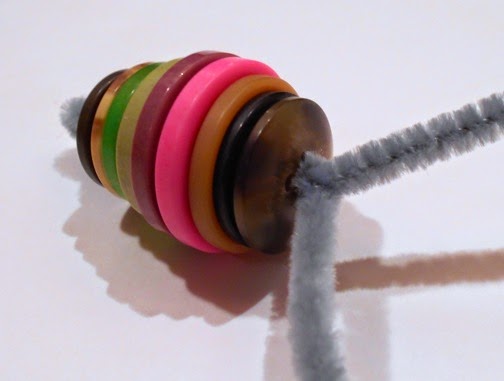I saw this idea in Martha Stewart's Favorite Crafts for Kids. The examples in the book were Christmas-related, but the principles looked like something I could adapt to make an elephant.
I have massive jars of buttons, so I just needed to buy pipe cleaners. I wasn't sure what would inspire me, so I bought a few in various colours and thicknesses.
I began by folding a grey pipe cleaner in half, then twisted a small loop at the end, where the tail would eventually go.
Next, I added buttons in various colours to make a fat body, by feeding both stems through holes in the buttons. If your buttons have four holes (as most of mine did), use holes that are diagonal to one another.
I made a twist at the front to hold the body together.
Most of the examples in the book are sort of button cylinders, with appendages such as legs and ears and tails made using pipe cleaners. I had a lot of very small buttons, so I decided to make the trunk as an extension of the head. At the end, I made two twists, then cut off the ends, twisted them again with a small pair of pliers and flattened them a bit to push in the sharp cut ends.
I also decided that, since elephants have thick, straight legs, I'd make those out of buttons, too. For each leg, I cut a pipe cleaner in half, and pushed both halves between the third and fourth button from the tail, and the third and fourth button from the head. Note that you need two stems on each side to hold the buttons in place.
I pulled both of them up and around to lock them around the main body pipe cleaner stem, but you can skip this step if you like.
To finish the ends of the legs, I did the same thing I'd done with the tip of the trunk.
I also added a small tail by twisting one of the pipe cleaner offcuts through the loop at the back of the body. I also gave it a bit of a kink.
And because an elephant is not an elephant without big, floppy ears, I cut another pipe cleaner in half and twisted both halves together around the gap between the body and head.
I chose a couple of big buttons, and finished the ends.
All of the elephants I make tend to be a bit top-heavy because of the trunk. To counteract this, I have a few tricks:
• Make the front legs ever so slightly longer, which tips the elephant back a bit.
• Splay the back legs slightly, and push the front ones closer together.
• Raise the elephant's trunk as much as possible.
• All of the above—which is what I did here.
This was easy and fun, and the end result is eccentrically cute, which is something I generally like to see in my growing herd.
Elephant Lore of the Day
Despite an elephant's size, it can be brought down by predators other than humans. In November 2014, tourists in Zambia's South Luangwa National Park watched in horror as a young elephant was attacked near a waterhole by 14 hungry lionesses. |
| A young elephant is attacked by 14 lionesses. Photo: Caters News Agency Source: Daily Mail |
For a time, it looked as though the lions had managed to bring the elephant down.
 |
| The lionesses bring the elephant to his knees. Photo: Caters News Agency Source: Daily Mail |
Suddenly, however, he rallied and ran into the water, where the lionesses had to decide whether they wanted the elephant enough to get a soaking. Most of them decided not.
 |
| The elephant shakes the elephants off in the water Photo: Steve Baker Source: Daily Mail |
After his quick dip in the water, the elephant emerged refreshed, and chased off the last of the lionesses. It was later discovered that the lions had killed a water buffalo instead. To read the full story, click here.
 |
| Reinvigorated, the elephant chases off the last of the lionesses. Photo: Caters News Agency Source: Daily Mail |
To Support Elephant Welfare
















No comments:
Post a Comment